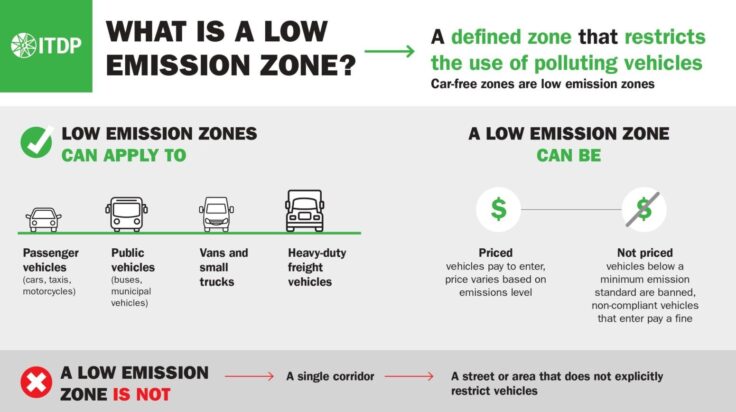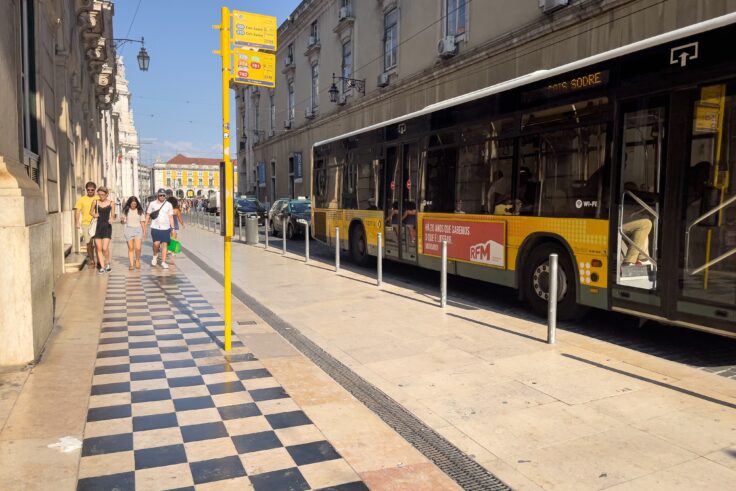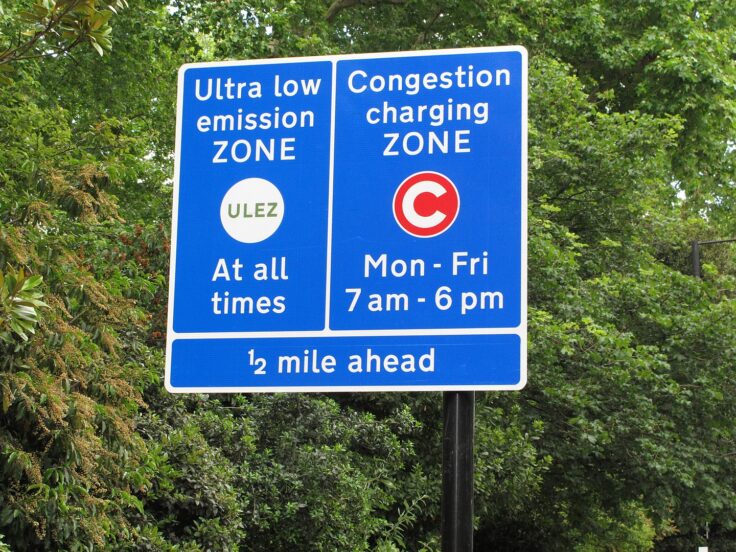February 22, 2023
What Is A Low Emission Zone?
The climate crisis is real, and its threats and consequences are more tangible than ever before. With the transport sector accounting for nearly 12 billion metric tons of greenhouse gas emissions, there needs to be a concerted effort to mitigate the impacts of emissions from road and passenger transportation.
ITDP’s Taming Traffic report takes a look at a range of traffic reduction strategies for reducing emissions and improving mobility.
In cities experiencing rapid urbanization especially, there is an urgent need to shift away from both private cars and transition to electric vehicles to tackle climate change, improve air quality, and reduce traffic injuries. Cities around the world must explore traffic reduction strategies that prioritize people and well-being, and require drivers to consider environmental and societal costs and opt for low-carbon modes of travel when possible. In recent years, low emission zones (LEZs) have grown in popularity as one potentially impactful strategy for cities to reduce dependence on motor vehicles and offer clean, affordable, accessible alternatives.
Building on ITDP’s Taming Traffic report that highlights various strategies for reducing driving, The Opportunity of Low Emission Zones Deep Dive report offers a closer look at LEZs to provide context and background for decision-makers and stakeholders interested in understanding the potential of these strategies for their city.

Defining LEZs
According to ITDP’s definition, a low emission or car-free zone is a contiguous zone that restricts the use of polluting vehicles through priced and non-priced strategies. Priced LEZs restrict vehicles by charging drivers a fee to enter. Typically, higher-polluting vehicles pay a higher fee, while hybrid or electric vehicles pay a lower fee or enter free of charge. Non-priced LEZs restrict vehicles by banning the highest-polluting vehicles from entering the zone. Violators are usually charged a significant fine. Individual corridors are not considered low emission zones because they are easy for drivers to avoid and will not spur a shift to cleaner vehicles. In general, LEZs can also have different sizes, pricing structures, operating models, terminology and restrictions.
LEZs have primarily been adopted as a method to directly impact and reduce transport-related pollutants, like particulate matter and nitrogen oxides, which threaten air quality and human health. The size, stringency, enforcement, and the presence and quality of non-car alternatives can all contribute to a LEZ’s impact on air quality. Currently, there are more than 320 low emission zones operating in Europe as of 2022, a growth of 40 percent compared to previous years. LEZs have been primarily implemented as an air quality improvement strategy in Europe, with a few non-European pilots and initiatives now underway in major cities such as Rio de Janeiro, Brazil (whose current LEZ plan is supported by ITDP Brazil); Haifa, Israel; Seoul, South Korea; and several Chinese cities. European-style LEZs (which require vehicle emissions standards, monitored entrances, etc.) have not as of yet been widely replicated in other regions.

Impacts and Outcomes
Low emission zones also present an opportunity for cities to achieve a broader set of goals beyond air quality improvement, such as improving access, safety, and equity, if the LEZ is designed well. LEZs, alongside complementary efforts to make public transport, cycling, and walking safer and more reliable, can make it easier for people to choose not to drive and opt for other transport modes. LEZs can also build on existing projects and catalyze new efforts to implement more high-quality walking, cycling, and transit infrastructure, compact land usage, and the electrification of vehicles.
There are several learnings to be gained from LEZs that have been in operation in European cities in recent years, particularly related to the impacts of different strategies. Priced LEZs have the potential to generate revenue for the city, however revenue generation should not be the primary goal of a LEZ, and publicly available data on revenues from such zones is still limited. However, any revenues can be invested to upgrade public transport, cycling, and walking infrastructure outside the zone, to ensure better mobility for lower-income and peripheral communities. If LEZs are large enough (i.e., drivers cannot simply take a different route to avoid the zone), they can also encourage a more widespread uptake of low- and zero-emission vehicles. Some trips will still need to be made with vehicles, and those vehicles should be made as low-emitting as possible across the board.

It is also important to consider that in priced LEZs, drivers of high-polluting vehicles which commute daily will quickly accrue costs, making equity an important issue to address. This cost can be very burdensome to low-income drivers since it represents a larger portion of their transportation budget. Low-income drivers are also less able to afford the higher cost of a newer, fuel-efficient vehicle that meets the LEZ standard for entry. To make compliance with LEZs more affordable and mitigate such impacts, certain incentives may be utilized, including purchase subsidies or tax credits for low- and zero-emission vehicles and e-bikes; discounts for public transportation; and mobility packages that bundle shared services. LEZs can be made equitable if designed accordingly while also emphasizing high-quality, accessible, and affordable transport alternatives to driving.
Ultimately, LEZs, car-free zones, and related policies are promising mechanisms for cities seeking to reduce emissions, tackle congestion, and improve air quality. While there are still few studies of the observed impacts of such zones once they are operating — especially in cities in the Global South, where there are fewer examples overall — LEZs have major potential to be impactful if coupled with transit-oriented and compact development measures. Looking forward, as LEZ pilots continue to develop in different cities, we expect to have more tangible methods for evaluating their outcomes, especially as a tool for promoting broader, more comprehensive sustainable development policies worldwide.
Read the full The Opportunity of Low Emission Zones: A Taming Traffic Deep Dive Report >>
Listen to ITDP’s Public Square Twitter Space on LEZs >>

